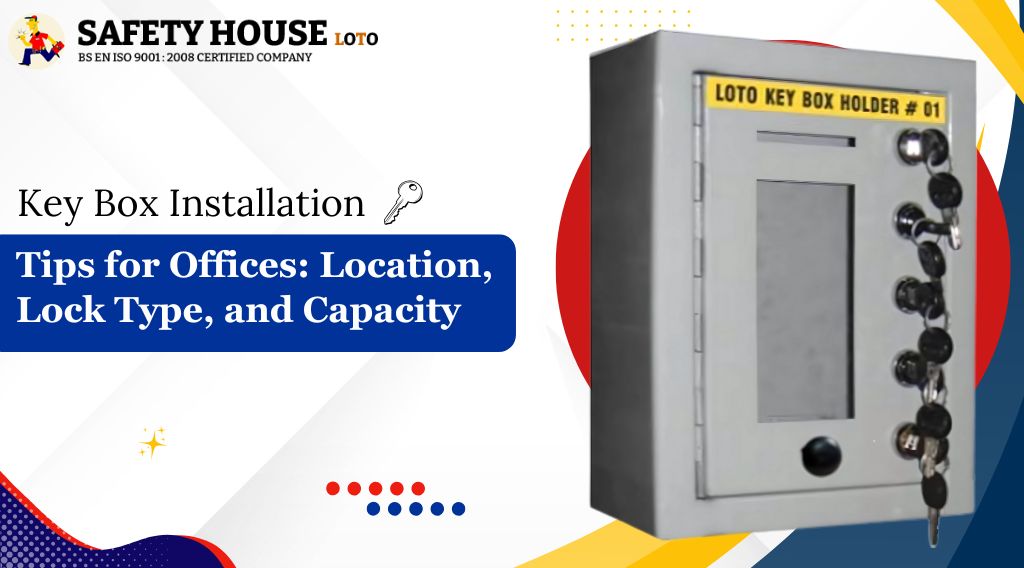
Key Box Installation Tips for Offices: Location, Lock Type, and Capacity
Posted On: June 9, 2025
Categorized In: Key Box
Written By: blog
Managing keys and locks in an office environment can be more complex than it seems. With growing concerns around safety, compliance, and access control, having a reliable key box for office use is no longer optional—it’s essential. For companies using LOTO locks (Lockout Tagout), it becomes even more critical to ensure keys are securely stored, easily accessible to authorized personnel, and organized systematically.
In this blog, we’ll explore important tips on key box installation for offices, focusing on three core aspects: location, lock type, and capacity. These factors, when considered carefully, help ensure safety, compliance, and operational efficiency. For organizations like Safety House Loto, which cater to industrial safety solutions, these practices are especially valuable for customers seeking the right key management system.
Why Key Boxes Are Essential in Office Environments
In today’s modern workplace, access control isn’t limited to just IT systems—it applies to physical spaces, equipment, and machinery as well. Whether it’s for facility access, equipment rooms, maintenance lockers, or LOTO lock keys, a well-installed key box can streamline operations while ensuring security.
Without a proper system in place, keys can be misplaced, misused, or fall into unauthorized hands, leading to serious security breaches or compliance violations.
Choosing the Right Location for Key Box Installation
1. Accessibility vs. Security Balance
When selecting a location for a key box in an office, strike the right balance between accessibility and security. It should be easily reachable for authorized users without being exposed to general foot traffic or public areas.
Recommended locations:
- Near the main electrical control panels or maintenance areas (especially for LOTO lock systems)
- Inside facility manager’s cabin or reception control desk
- In a controlled access room, such as a security or operations room
2. Avoid External Wall Installations
Avoid installing key boxes on exterior-facing walls or near exit doors unless they are within a secure internal office premise. Exposed locations can increase the risk of tampering or theft.
Lock Type: Choose What Matches Your Security Needs
The locking mechanism of the key box is crucial, especially when handling LOTO locks or sensitive access keys.
1. Traditional Key Locks
These are cost-effective and simple to use but may not be ideal for high-security needs. They are best suited for smaller offices or less critical key storage.
2. Combination Locks
A step up in security, combination lock key boxes eliminate the need for managing additional keys. Ensure the combination is changed periodically and known only to authorized personnel.
3. Digital or Smart Lock Systems
Ideal for larger organizations or industrial environments. Digital key boxes can include PIN access, biometric scanners, or card readers. These are particularly useful for LOTO lock storage, where strict access control and audit trails are necessary.
Key Box Capacity: Plan for Present and Future Needs
One common mistake offices make is underestimating how many keys they’ll need to store—not just today, but in the future.
1. Evaluate Current Requirements
Start by counting all essential keys, including those for:
- Electrical and mechanical rooms
- LOTO lock systems
- Server and data centers
- Restricted access storage areas
2. Plan for Expansion
It’s wise to choose a key box with slightly higher capacity than your current need. Modular or expandable models offer flexibility as your office infrastructure grows.
Labeling and Key Organization
Even the best key box for office use can become inefficient without proper organization.
Best Practices:
- Use numbered hooks and corresponding labels
- Maintain a logbook or digital key tracking system
- Assign color codes for different departments or types of access
- Use tamper-evident tags for LOTO lock keys to ensure safety compliance
Integration with Lockout Tagout Procedures
If your office environment includes machinery or equipment that requires lockout-tagout, the key box should align with your LOTO procedure. This includes:
- Isolating LOTO lock keys from general-use keys
- Restricting access only to trained and authorized personnel
- Using group lockout boxes when multiple workers are involved
Integrating a key box into your LOTO protocol reduces confusion, prevents unauthorized operation of locked equipment, and ensures OSHA compliance.
Conclusion
Installing a key box in an office setting isn’t just about storing keys—it’s about promoting safety, organization, and accountability. By carefully considering the location, selecting the right locking mechanism, and planning for the appropriate capacity, businesses can ensure a secure and efficient key management system.
For safety-focused environments or those with LOTO lock requirements, these practices are even more essential. Organizations like Safety House Loto provide a range of safety solutions designed to support industries in maintaining safe and compliant workplaces. Whether you’re upgrading your safety protocol or planning a new facility layout, don’t overlook the importance of a well-planned key storage system.
